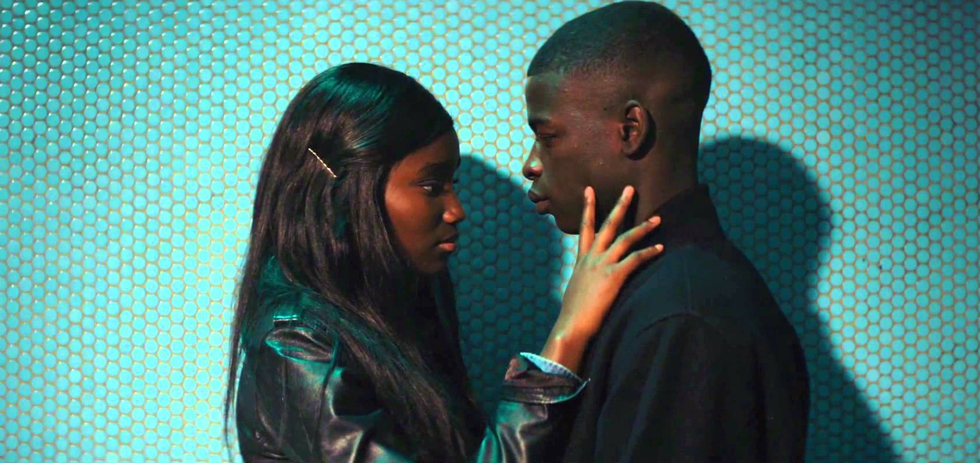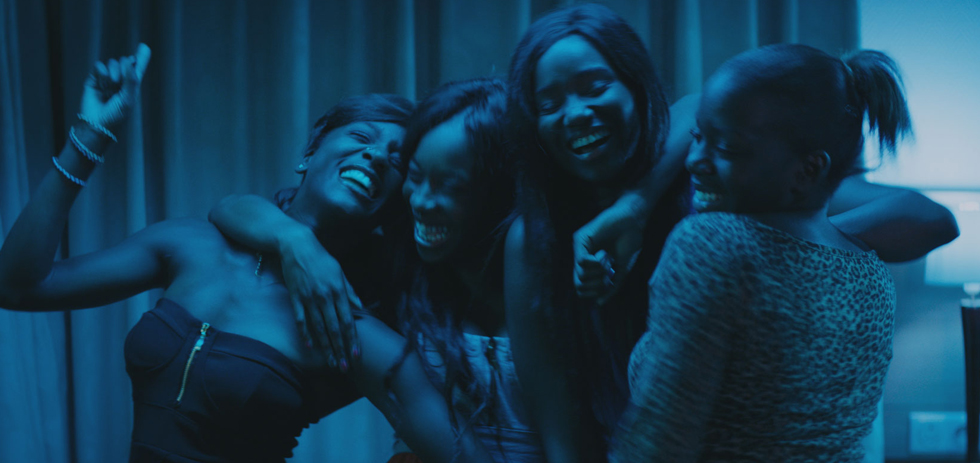
By far her most ambitious effort, Céline Sciamma’s Girlhood is the final instalment in what she describes as her ‘coming of age trilogy’, which forms a unique portrait of complex and varied femininities. With a sensitive understanding of youth, sexual and gender ambiguities that could certainly give the likes of Gus Van Sant a run for their money, Sciamma’s films make their mark in the already overflowing genre of adolescent films, shining a light on the female experiences that society so often places on the margins.
Originally titled Bande de filles in French (which translates to bunch or gang of girls), Girlhood follows Marieme (Kardija Touré), a black teenage girl living in the outer suburbs of Paris with her largely absent working mother, younger sisters and abusive older brother. When she storms through her school yard after finding out she can’t progress to high school, Marieme attracts the attention of a trio of local girls. Identifying with Marieme’s apparent isolation and frustration, the group’s ringleader, a girl known as Lady (Assa Sylla), initiates her into their group of rebellious girls, all of whom display a seductive sense of agency and independence from the authoritative forces of family life and the patriarchy. In their testing of limits, the girls are shown stealing, smoking pot and underage drinking, and yet the film, unlike many teen movies about the white, bored and affluent, does not romanticise these behaviours, but rather places its focus on the more innocent solidarity that forms between the girls.
The first two segments in the film’s three chapter narrative structure form a celebration of female friendship. In the world of Girlhood, romantic relationships are present but secondary, a rarity for women on screen — particularly in LGBT cinema, which is still recovering from a complete lack of visibility regarding our romantic stories. We see women who are constantly and genuinely telling each other they are beautiful, and while we’re shown a vicious rivalry with other gangs in their block, there is none of the cattiness we have long been taught to expect of films that deal with teenage girls.
Marieme is shown as having a close, physically affectionate relationship with her younger sister, which is juxtaposed with the violence of her older brother. This frames the gendered relationships for the rest of the film, wherein Marieme is constantly seeking connection with other women, experiencing pain of some kind in all of her interactions with men. The film also explores the monitoring effect of the male gaze; our joy as a viewer in seeing the scenes of bold female empowerment is thus always undermined. We may revel in the film’s expressions of sexual autonomy shown by a fully dressed Marieme grazing her hand over her boyfriend’s bare skin (Djibril, played by Cyril Mendy), shot with an exploitative cinematic gaze usually reserved for depicting the female body, yet this is tainted by seeing her be beaten and slut-shamed by her brother in the very next scene. This dynamic is established early on through a sequence in which a group of girls are seen joyfully laughing together while walking home only to fall immediately silent at the sight of a gang of men ahead, so as to not attract unwanted attention. Such a subtle observation, that will likely ring painfully true for any female audience member, is indicative of Sciamma’s politically charged yet understated storytelling.

With Girlhood, Sciamma departs from the far more grounded realism of Water Lilies (2006) and Tomboy (2011), creating moments of suspended reality in which the girls are able to escape the mundanity of their lives by indulging their fantasies. This urge in many teenagers to elevate and glamourize themselves out of awkward adolescence is eloquently encapsulated in the hotel scene. The four girls, dressed up for no one but themselves, sing and dance together along to Rihanna’s “Diamonds”, illuminated by exaggerated blue lighting. The whole song is played out so that rather than this being a brief flicker of silliness, the scene evokes sustained passion and camaraderie as they belt out the affirming mantra of the song’s repetitive lyrics. This sequence is also the turning point for Marieme, now using the moniker Vic, as she moves from a hanger-on to a central part of the group. This newfound kinship, particularly with Lady, is cemented in a tightly-framed shot where the focus shifts between the two girls as they sway in alternate directions, moving slowly and theatrically to the song’s peak before shifting into the chorus and the girls dancing clumsily in a circle.
Both Girlhood and Tomboy represent the tension between the identities forced upon us within the anchoring of the domestic setting, and the freedom of the anonymity of external social realms that allow space for one to reinvent themselves. Exploring the transformative and malleable nature of identity, both films use renaming gestures — we see the feminized ‘Laure’ in Tomboy become the masculine ‘Mikael’, and the passive and hesitate ‘Marieme’ become the confident ‘Vic’. This performance of identity is emphasised through the changing and distinct appearances that Vic adopts throughout the film. In the final chapter we see her presenting herself in dual extremes — a constructed femininity of wig and dress when drug dealing at the parties of the white and rich, and a decidedly masculine dress with short cornrows and a bound chest when not. The latter is both an ambiguous mixture of adopting a new gender expression and a tactic to move more freely in the rough world of men within the drug cartel. This exploration of gender non-conformity is accompanied by a questioning of her sexuality. This trial of identities is once again monitored by patriarchal forces, which come to a poetic head when the woman Vic is dancing with leaps dutifully out of frame in response to a male presence, as Vic is suddenly embraced from behind.
The film’s aesthetic achievement is a culmination of the longstanding collaboration between Sciamma, cinematographer Crystel Fournier and electronic musician and producer Jean-Baptiste de Laubier, aka Para One, who both worked on her previous features. Para One’s “Girlhood”, written for the film, is used as a recurring motif played over a black screen at each point of new resolve for Marieme. This intensely resonant and surprisingly not tiresome device draws the viewer into Marieme’s emotional journey with a track that is inspiringly present while at the same time evoking a pre-emptive nostalgia. The film is visually sublime, with Fournier’s minimalist style creating a majesty out of the wide urban spaces of outer Paris, and making the piece very much deserving of a big-screen viewing.
It is hard to not fall in love with what is arguably Sciamma’s best film yet. While much of the film does deal with restriction and struggle, Girlhood is, on the whole, a pleasure to watch and a must see of 2015, for both its formal mastery and rare kaleidoscopic rendering of emerging womanhood.
Around the Staff
| Conor Bateman | |
| Felix Hubble | |
| Dominic Barlow |
